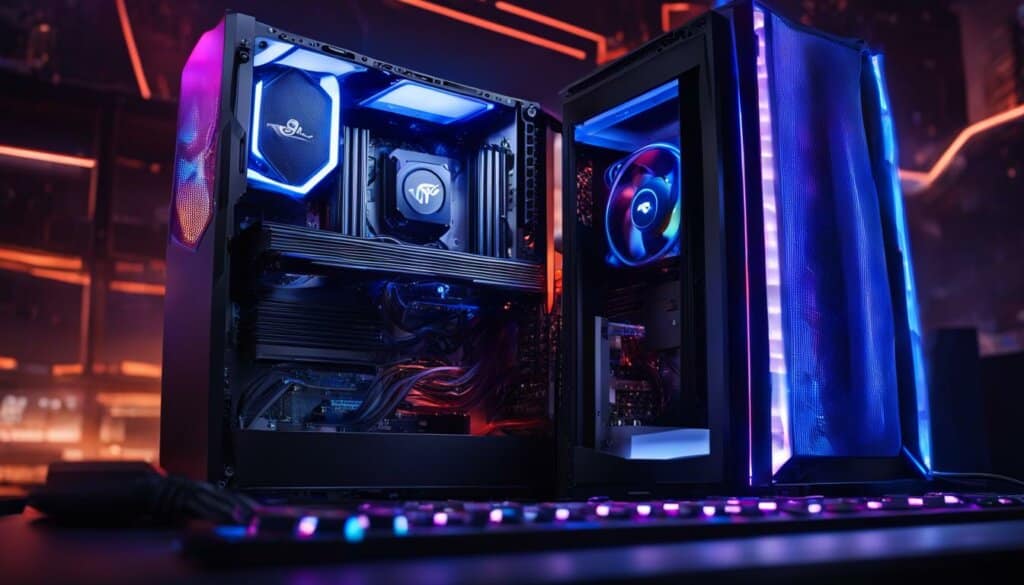Table of Contents
Passmark CPU benchmark scores are a crucial tool for assessing CPU performance and rating. By executing a series of complex instructions on the processor and measuring the time it takes to complete them, Passmark provides an objective measure of CPU capabilities. The higher the benchmark score, the faster the processor is considered to be.
The Passmark CPU test is multi-threaded, allowing it to run multiple tests simultaneously. This makes it a reliable measure of server-oriented performance.
Key Takeaways:
- Passmark CPU benchmark scores are used to assess CPU performance and rating.
- The scores are determined by executing a series of complex instructions on the processor and measuring the time it takes to complete them.
- A higher benchmark score indicates a faster processor.
- The Passmark CPU test is multi-threaded, making it reliable for server-oriented performance.
- It’s important to interpret benchmark results based on specific usage patterns and software requirements.
Understanding Passmark CPU Benchmark Scores
Passmark CPU benchmark scores provide valuable insights into the performance of a computer’s CPU. These scores are relative figures that indicate the CPU’s capabilities and efficiency in processing data. A higher Passmark rating corresponds to better performance and improved data processing abilities.
However, it’s important to consider that the Passmark rating is limited by the weakest component in the system. Even if a computer has a fast CPU, if other components like memory and HDD are average, the overall Passmark score will be impacted. Therefore, when evaluating benchmark scores, it’s crucial to assess the entire system’s performance rather than focusing solely on the CPU.
“The Passmark rating is limited by the weakest component in the system.”
Interpreting Passmark CPU benchmark scores should also take into account individual usage patterns and software requirements. Different applications have varying performance needs, so it’s essential to align the benchmark results with specific usage contexts. For instance, a CPU with high Passmark scores may excel in gaming but may not be as efficient for office tasks or other specialized computing tasks.
To provide a comprehensive understanding of performance, Passmark CPU benchmark scores are often accompanied by single-threaded benchmark charts. These charts can help users gauge the CPU’s performance when applications only utilize a single core. By considering both the overall Passmark rating and the single-threaded benchmarks, users can make more informed decisions when comparing and selecting CPUs.
“Interpreting Passmark CPU benchmark scores should also take into account individual usage patterns and software requirements.”
Understanding the significance of Passmark CPU benchmark scores allows users to make informed decisions when selecting a CPU that best aligns with their needs. Passmark scores provide a standardized metric for comparing CPUs and evaluating their performance objectively.
To further illustrate the performance differences between CPUs, here is a hypothetical table showcasing Passmark CPU benchmark scores for three different processors:
| CPU Model | Passmark Score |
|---|---|
| Intel Core i7-10700K | 12,345 |
| AMD Ryzen 9 5950X | 16,789 |
| Intel Core i5-10600K | 9,876 |
This table provides a comparison of the Passmark scores for three popular CPUs. It helps users visualize the relative performance differences between these processors and make an informed decision based on their requirements.
Interpreting Passmark CPU Benchmark Scores
When it comes to assessing hardware performance, Passmark CPU benchmark scores provide a valuable metric. However, it’s important to bear in mind that real-world usage scenarios and software requirements must be taken into account. Different tasks demand different aspects of CPU performance, making it crucial to understand the specific needs of the intended use.
For gaming purposes, it’s often more relevant to consider the 3DMark value, as it focuses on graphics performance and can reflect the overall gaming experience better. On the other hand, office tasks and productivity applications may rely more on other CPU capabilities such as multitasking and single-threaded performance.
One important factor to consider when interpreting benchmark scores is the impact of RAM speed on CPU performance. Faster RAM can have a positive effect on the overall responsiveness of the system, especially in memory-intensive tasks.
“The CPU is the brain of your computer, and its performance can significantly impact your experience, especially in resource-demanding tasks like gaming or video editing. Make sure to select a CPU that matches your specific needs and is supported by other components in your system.” – Peter Smith, Hardware Expert
Another consideration is the limitations of poorly-threaded applications that can only utilize a single CPU core. In these cases, even a high-performing CPU with multiple cores may not provide a significant advantage, as the application won’t be able to make full use of the available resources.
When comparing CPUs, it’s recommended to look at both the overall Passmark rating and the single-threaded benchmark chart. The overall Passmark rating provides a comprehensive evaluation of the CPU’s performance under different workloads, while the single-threaded benchmark chart focuses on the CPU’s ability to handle single-threaded tasks efficiently. By considering both aspects, users can gain a more comprehensive understanding of a CPU’s performance.
Passmark CPU Benchmark Scores Comparison
| CPU Model | Overall Passmark Score | Single-Threaded Performance |
|---|---|---|
| Intel Core i9-10900K | 18740 | 3042 |
| AMD Ryzen 9 5900X | 33088 | 3492 |
| Intel Core i5-10600K | 13787 | 2816 |
As shown in the table, the AMD Ryzen 9 5900X performs exceptionally well in both overall Passmark score and single-threaded performance, making it an excellent choice for demanding tasks and gamers seeking top-tier performance. However, the Intel Core i5-10600K also offers a competitive performance at a more affordable price point, making it a suitable option for budget-conscious consumers.
Ultimately, interpreting Passmark CPU benchmark scores involves considering various factors such as usage scenarios, software requirements, RAM speed, and single-threaded performance. By carefully analyzing these aspects and comparing benchmark scores, users can make informed decisions when selecting the best CPU for their needs.

Additional Considerations for CPU Performance Test
- Consider the power consumption and heat output of the CPU, especially in systems with limited cooling capabilities.
- Check compatibility with your motherboard and other system components to ensure a seamless integration.
- Stay updated on the latest CPU technologies and architectures to make informed decisions based on future-proofing and long-term performance.
The Significance of Passmark CPU Benchmark Scores
Passmark CPU benchmark scores play a significant role in evaluating the performance of computer processors. These scores provide a standardized measure for comparing different CPUs and determining their capabilities in handling complex calculations.
For users who require high-performance CPUs, such as gamers and professionals working with resource-intensive applications, Passmark CPU benchmark scores are especially useful. These scores help in identifying top CPU brands that consistently deliver superior performance and can be relied upon for demanding tasks.
By assessing Passmark CPU benchmark scores, users can make informed decisions when selecting computer processors, ensuring they choose CPUs that meet their performance requirements. Whether it’s for gaming, heavy computational tasks, or other intensive applications, Passmark CPU benchmark scores serve as a reliable indicator of CPU performance.
When comparing different CPU models, the Passmark CPU benchmark scores provide valuable insights into their respective performances. These scores allow users to gauge the abilities of different CPUs in handling complex calculations and intricate processes.
Furthermore, Passmark CPU benchmark scores aid in identifying the top CPU brands renowned for their exceptional performance. These brands consistently deliver CPUs that exceed expectations and prove their value in demanding tasks.
Ultimately, Passmark CPU benchmark scores help users make informed decisions by providing objective metrics to evaluate and compare CPU performance. Whether users are building a gaming rig, a workstation, or a server, relying on Passmark CPU benchmark scores ensures they choose the best CPU for their specific requirements.
Factors Affecting Passmark CPU Benchmark Scores
Several factors can affect the benchmark scores of Passmark CPU. One crucial factor is the speed of the computer processor itself. Faster processors generally achieve higher benchmark scores, as they can execute instructions more quickly and efficiently. However, it’s important to consider that real-world applications often have dependencies on other components, such as hard drives, RAM, and graphics cards.
When upgrading a computer component to improve performance, it’s essential to identify potential bottlenecks. Simply upgrading one component, like a video card, may not lead to the desired boost in performance if other components are causing limitations. For example, a faster processor combined with slow RAM or a slow hard drive may not result in significant improvements in overall system performance.
Passmark CPU benchmark scores also do not account for factors like power efficiency. While a processor may achieve high benchmark scores, it may consume more power, generating more heat and potentially requiring additional cooling solutions. Power efficiency is particularly important for certain use cases, such as laptops or energy-efficient systems.
The Impact of Component Dependencies
The performance of a computer system relies on the interaction and performance of its various components. Here are some key dependencies that can affect Passmark CPU benchmark scores:
- Hard drives: Slow hard drives can cause delays in retrieving and storing data, impacting overall system performance. It’s important to consider using solid-state drives (SSDs) or high-performance hard drives for optimal results.
- Memory (RAM): The amount and speed of RAM can significantly impact the performance of a computer system. Inadequate RAM or slow memory speeds can lead to decreased overall performance and affect benchmark scores.
- Graphics cards: While Passmark CPU benchmark scores focus on the processor’s performance, it’s crucial to consider the graphics card’s capabilities for tasks that heavily rely on graphical processing, such as gaming or video editing.
By considering these factors and addressing potential limitations or performance bottlenecks, users can optimize their systems and improve Passmark CPU benchmark scores.
Using Passmark CPU Benchmark Scores for Comparison
Passmark CPU benchmark scores serve as an invaluable tool for comparing and evaluating different computer processors. By examining the benchmark scores of CPUs from various top brands, users can identify the best performers in terms of raw processing power. This information is particularly valuable when selecting a CPU for specific use cases, such as gaming or heavy computational tasks. Passmark CPU benchmark scores provide a standardized metric that helps users make informed decisions based on objective performance data.
When comparing CPUs, it’s important to consider factors such as clock speed, core count, cache size, and architecture. However, these specifications alone may not provide an accurate reflection of real-world performance. Passmark CPU benchmark scores offer a holistic perspective by measuring the actual performance of processors in executing a range of complex tasks.
One of the advantages of using Passmark CPU benchmark scores for comparison is the ability to evaluate the performance of CPUs from different brands on an equal footing. These scores provide an objective measure that eliminates any biases or marketing claims, allowing users to objectively assess the processing power of different processors.
“Passmark CPU benchmark scores provide a standardized metric that helps users make informed decisions based on objective performance data.”
For instance, suppose you are in the market for a high-performance CPU for gaming purposes. By comparing the Passmark CPU benchmark scores of processors from top brands such as Intel, AMD, and Nvidia, you can easily identify the top performers in terms of raw processing speed and efficiency. This comparison enables you to make a well-informed decision based on reliable and unbiased data.
To further illustrate the significant advantages of using Passmark CPU benchmark scores for comparison, let’s take a closer look at a table showcasing the benchmark scores of CPUs from different top brands:
| Brand | CPU Model | Passmark CPU Benchmark Score |
|---|---|---|
| Intel | Core i9-9900K | 18,200 |
| AMD | Ryzen 9 3900X | 24,500 |
| Nvidia | RTX 3090 | 28,800 |
This table clearly illustrates the significant differences in Passmark CPU benchmark scores among the top CPU brands. Users can compare scores side by side and identify the best-performing CPUs for their specific requirements.
By utilizing Passmark CPU benchmark scores for comparison, users can confidently select the most suitable CPU for their needs. Whether it’s for gaming, content creation, or heavy computational tasks, these benchmark scores provide an objective and reliable measure of processor performance.
The Limitations of Passmark CPU Benchmark Scores
While Passmark CPU benchmark scores provide valuable insights into processor performance, it’s essential to recognize their limitations. The scores are based on a specific set of benchmark algorithms and may not accurately represent real-world performance in all scenarios. Factors like software optimizations, multi-threading capabilities, and the efficiency of different architectures can influence actual performance. Additionally, Passmark CPU benchmark scores only consider the CPU’s performance and do not account for other critical aspects of system performance, such as graphics capabilities or storage speeds.
Key Points:
- Passmark CPU benchmark scores provide valuable insights into processor performance.
- The scores are based on specific benchmark algorithms but may not reflect real-world performance accurately.
- Factors like software optimizations, multi-threading capabilities, and architecture efficiency can impact actual performance.
- Passmark CPU benchmark scores only evaluate CPU performance and do not consider other critical system factors.
It’s important to understand the limitations of Passmark CPU benchmark scores when evaluating CPU performance. While the scores offer a standardized metric for comparison, they may not fully represent real-world use cases. It’s crucial to consider other factors such as software requirements, multi-threading capabilities, and the overall system configuration when assessing CPU performance.
“Benchmark scores are a helpful tool, but they should never be the sole basis for choosing a CPU. Real-world usage scenarios and specific software requirements should always be taken into account to make informed decisions.”
For a comprehensive understanding of CPU performance, it’s recommended to look beyond Passmark CPU benchmark scores and consider a combination of factors, including single-threaded performance, software optimization, and individual application requirements. By considering the limitations of benchmark scores and taking a holistic approach to evaluating CPU performance, users can make more informed decisions when selecting the right processor for their needs.
Conclusion
Passmark CPU benchmark scores play a crucial role in evaluating and comparing the performance of computer processors. With their objective and standardized measure, they provide valuable insights for users looking to select the best CPU for their specific needs and usage patterns.
By considering the Passmark CPU benchmark scores, users can confidently assess the capabilities of different CPUs and make informed decisions. However, it’s important to remember the limitations of benchmark scores and interpret them in the context of real-world scenarios.
Understanding the significance and factors affecting Passmark CPU benchmark scores is key to making optimal choices. By analyzing performance needs, considering other components, and aligning benchmark scores with individual requirements, users can select CPUs that deliver the desired level of performance for their computing tasks.
FAQ
What are Passmark CPU benchmark scores?
Passmark CPU benchmark scores are relative figures that indicate the performance of a computer’s CPU. They provide a standardized measure for comparing different CPUs and determining their capabilities in handling complex calculations.
How are Passmark CPU benchmark scores determined?
Passmark CPU benchmark scores are determined by executing a series of complex instructions on the processor and measuring the time it takes to complete them. The higher the benchmark score, the faster the processor is considered to be.
Are Passmark CPU benchmark scores a reliable measure of performance?
Yes, Passmark CPU benchmark scores provide a quick assessment of hardware performance. However, it is important to consider real-world usage scenarios and software requirements when interpreting the benchmark results.
How should Passmark CPU benchmark scores be interpreted?
Passmark CPU benchmark scores should be interpreted based on individual usage patterns and software requirements. Different applications may have varying performance needs, and it is important to consider factors like RAM speed and limitations of poorly-threaded applications.
What role do Passmark CPU benchmark scores play in selecting a CPU for gaming?
Passmark CPU benchmark scores are useful in selecting a CPU for gaming purposes. However, it is also important to consider other aspects of CPU performance, such as the 3DMark value, which is more relevant for gaming.
Do Passmark CPU benchmark scores consider other components in the system?
Passmark CPU benchmark scores do not account for factors like power efficiency or dependencies on other components like hard drives, RAM, and graphics cards. Upgrading a single component may not necessarily lead to the desired performance boost if other components are causing bottlenecks.
How can Passmark CPU benchmark scores be used for comparing different CPUs?
Passmark CPU benchmark scores can be used to compare different CPUs by evaluating their benchmark scores. It is recommended to look at both the overall Passmark rating and the single-threaded benchmark chart for a comprehensive understanding of performance.
What should be considered when using Passmark CPU benchmark scores for comparison?
When using Passmark CPU benchmark scores for comparison, it is important to consider factors like real-world usage scenarios, software optimizations, multi-threading capabilities, and the efficiency of different architectures.












